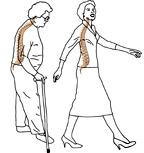 Based on a position paper of the American Council on Science and Health (ACSH) by Felicia Cosman, MD, Medical Director, Clinical Research Center, Helen Hayes Hospital. February 2005
Based on a position paper of the American Council on Science and Health (ACSH) by Felicia Cosman, MD, Medical Director, Clinical Research Center, Helen Hayes Hospital. February 2005 Based on a position paper of the American Council on Science and Health (ACSH) by Felicia Cosman, MD, Medical Director, Clinical Research Center, Helen Hayes Hospital. February 2005
Based on a position paper of the American Council on Science and Health (ACSH) by Felicia Cosman, MD, Medical Director, Clinical Research Center, Helen Hayes Hospital. February 2005
Executive Summary Osteoporosis is a disease in which bones become fragile and more likely to break. Currently, about 8 million women and 2 million men in the United States have this debilitating disease.
The majority of bone mass is achieved during the first two decades of life and on average, it reaches a peak during the early 20s or late teens. While bone mass is determined by a host of environmental and genetic factors, it is maintained by a process called remodeling, which involves the continuous breakdown and reformation of bone. In young adults, the bone created is equal to the bone that is removed, and the frequency with which bone remodeling units are activated is constant. As a result, bone remodeling is balanced.
With advancing age, this balance shifts and sets the stage for osteoporosis. Measuring bone mineral density (BMD) is the only way to accurately diagnose osteoporosis and predict risk for future fractures, and today the gold standard is a test called dual X-ray absorptiometry (DXA). The National Osteoporosis Foundation recommends that all women have their BMD measured by age 65 or earlier if other risk factors are present. If your test reveals that you have osteoporosis, it implies that you are at an increased risk of sustaining a fracture. About 1.5 million osteoporosis-related fractures occur each year in the US, costing about $15 million annually. Fractures can cause pain, swelling and difficulty with movement. As such, they often have a pronounced effect on quality of life.
Along with surgery to repair existing fractures, certain medications can be prescribed to reduce fracture risk among people at highest risk. Moreover, certain prevention approaches can be helpful in staving off fracture-causing falls. These include a thorough medication review to determine if any medications cause drowsiness or dizziness, eliminating exposed wires and slippery rugs and getting regular eye exams. There are currently no accepted guidelines for monitoring osteoporosis treatment. However, as most treatments produce small or moderate bone mass changes, follow-up DXA can be useful after a sufficient amount of time has passed. Osteoporosis is preventable to some degree.
The first line of prevention includes good nutrition, regular weight-bearing exercise, not smoking and avoiding excessive alcohol consumption. While osteoporosis cannot be cured, certain medications along with simple strategies to prevent falls around the home can reduce fracture risk. It s extremely important to talk to your doctor about bone health.
The good news is that the future is looking bright. Research is currently underway that aims to improve diagnosis and develop newer and even more effective treatments.
Also see Felicia Cosman, M.D.'s Medscape.com report on osteoporosis, citing ACSH: http://www.medscape.com/viewprogram/4011 The Prevention and Treatment of Osteoporosis: A Review


